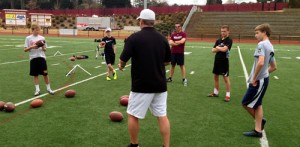Coaching Kickers in Spring Practice
 Spring break, blooming flowers, pollen (you know my pain if you live in a place like Atlanta), and SPRING FOOTBALL. Spring practice is a great time to evaluate new competition, get acquainted with the playbook, and to develop skills and fundamentals. Kickers can sometimes get lost in the shuffle of a jam-packed spring…so what goes into coaching kickers in the spring?
Spring break, blooming flowers, pollen (you know my pain if you live in a place like Atlanta), and SPRING FOOTBALL. Spring practice is a great time to evaluate new competition, get acquainted with the playbook, and to develop skills and fundamentals. Kickers can sometimes get lost in the shuffle of a jam-packed spring…so what goes into coaching kickers in the spring?
Muscle Memory and Drills
Spring is one of the few times I would say it is okay to kick more than normal. Since you do not have any games right around the corner, you can really exert some energy into getting better. I want to be clear…I am not saying to go out and kick 100 footballs each practice. Instead of kicking a recommended ~30 field goals per practice, now go with ~40 field goals.
But don’t stop at kicking a few more field goals. Now is the time to work on drills, drills, and more drills. Drills are not always the most fun things to go through, but they will make you a more consistent kicker.
 Follow these drills during spring (and continue practicing in the summer) and you will be a different kicker on Friday nights.
Follow these drills during spring (and continue practicing in the summer) and you will be a different kicker on Friday nights.
- Dry Steps: Simply set your tee down, take your field goal steps back and to the side. Mark where you end up. You should be ending within an inch of your mark every time. If you want to get more advanced, work from the hashes. The concept is simple, but getting your steps to be the exact same every time will make a huge difference. Imagine Tiger Woods standing 3 inches closer to a ball on one drive versus another…think it will make a difference? You bet it will!
- Dry Runs: This can be joined with Dry Steps. Once you have taken your steps back and to the side, go through your steps in real speed and act like you are going to kick the ball (without a football actually being there). You want to make sure your shoulders and hips are pointed at the middle of the uprights on your follow through (you will naturally fall off to the left as a right footed kicker, but your shoulders and hips should still be pointed at the center of the uprights). Mark where you end your follow through and try to end there every time.
- Straight Steps: Take your steps back and to the side. Before you start your approach place a string, piece of tape, a tent pole, or anything else you can find to draw a straight line from the middle of your stance and end it between your tee and where your plant foot will be. The goal of this drill is to keep each foot on the correct side of the line, which will keep you going straight to the ball.
Chemistry (Snap to Kick)
There is limited opportunity to get the snapper, holder, and kicker together in one session. Take advantage while you can! Kick before practice, during practice, and after practice with a live snap, hold, and kick. You want to be just as comfortable kicking with a live snap and hold as you are kicking off of a stationary holder. The refs aren’t going to let you take your time so the ball can be set perfect for you in a game.
Coaching Kickers in Tough Situations
Make sure you (or your kicker) is placed in some really tough situations in spring practice/spring game. When I was at Georgia Tech, our coach would stop practices randomly, have the field goal team go out while the whole team was watching and kick a set of field goals. As a kicker, this really helped me learn how to be ready at any moment and have the pressure of your peers watching you. Another way to add a little pressure is to put something on the line for your last kick. Our coach would take away some sprints if I made the field goal, needles to say it got the whole team involved and cheering on the field goal unit.
